engine overheat AUDI R8 SPYDER 2011 Owners Manual
[x] Cancel search | Manufacturer: AUDI, Model Year: 2011, Model line: R8 SPYDER, Model: AUDI R8 SPYDER 2011Pages: 244, PDF Size: 59.74 MB
Page 14 of 244
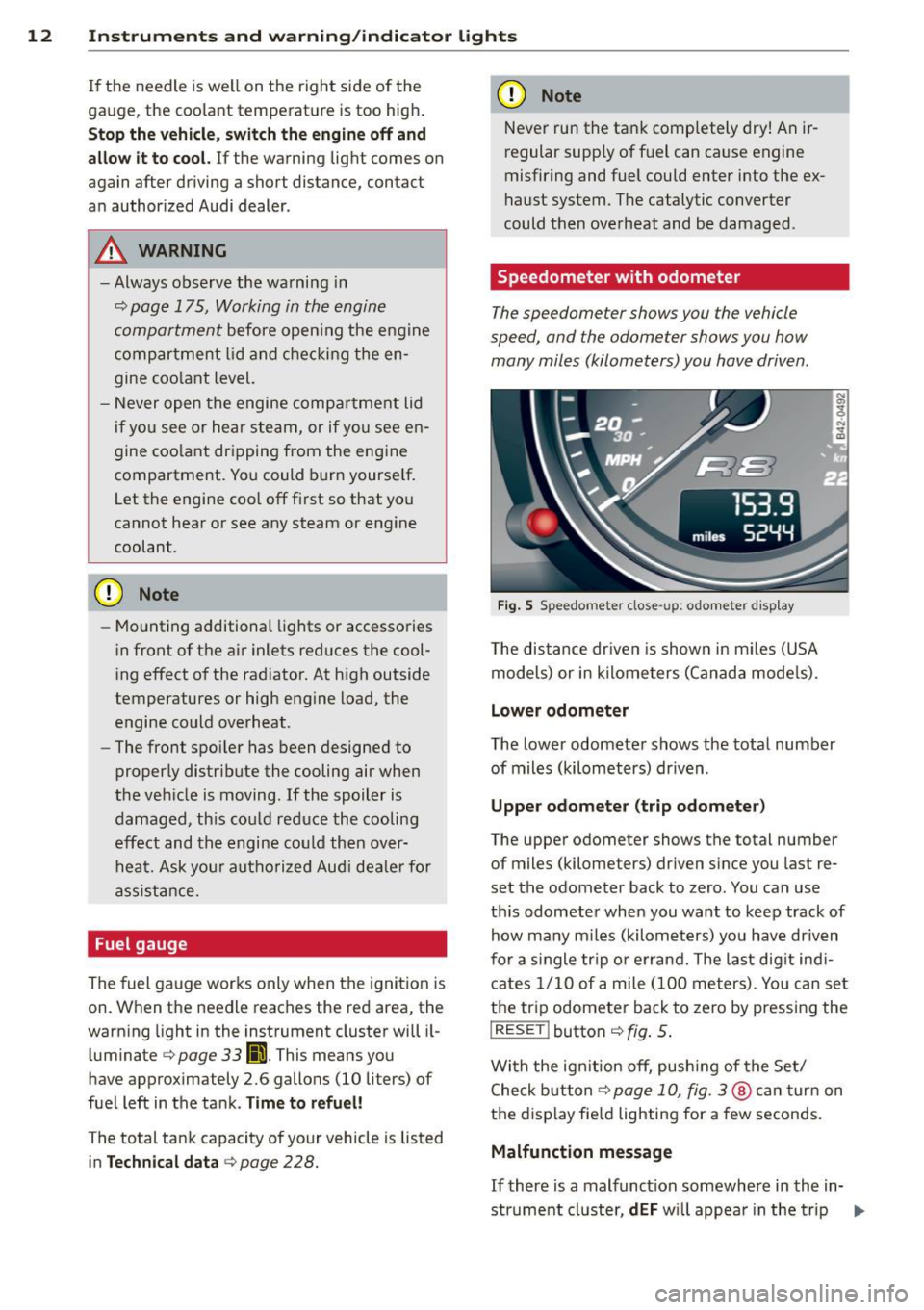
12 Instruments and warning /indicator lights
If the needle is well on the right side of the
gauge, the coolant temperature is too high .
Stop the vehicle, switch the engine off and
allow it to cool.
If the warning light comes on
again after driving a short distance, contact
an author ized Audi dealer .
A WARNING
-Always observe the warni ng in
¢ page 175, Working in the engine
compartment before opening the engine
compartment lid an d checking the en
gine coo lant level.
- Never open the engine compartment lid
if yo u see or hear steam, or if you see e n
gine coolant dripping from the engine
compartment . You could burn yourse lf.
Let the engine coo l off first so that you
cannot hear or see any steam or engine
coolant.
(D Note
- Mounting additional lights or accessories
in front of the air inlets red uces the cool
i ng effect of the radiator. At h igh outside
temperatures or high engine load, the
engine could overheat .
- The front spo iler has been designed to
properly distribute the cooling air when
the veh icle is moving. If the spoiler is
damaged, th is could reduce the cooling
effect and the engine could then over
heat. Ask you r autho rized Aud i dealer for
ass istan ce.
Fuel gauge
The fuel gauge works only when the ignition is
on. When the needle reaches the red area, the
warn ing light in the instrument cluster will il
lum inate
c> page 33 (il This means you
have approximately 2.6 gallons (10 liters) of
fuel left in the tank .
Time to refuel!
The total tank capacity of your vehicle is listed
in
Technical data ¢ page 228.
(D Note
Never run the tank completely dry! An ir
regular supply of fuel can cause engine
misfiring and fuel could enter into the ex
haust system . The catalytic converter
could then overheat and be damaged.
· Speedometer with odometer
The speedome ter shows you the vehicle
speed, and the odometer shows you how
many miles (kilometers) you have driven .
Fig. S Speedometer close -up: odome ter d isplay
The distance driven is shown in m iles (USA
models) or in kilometers (Canada mode ls).
Lower odometer
The lower odometer shows the total number
of miles (kilometers) dr iven .
Upper odometer (trip odometer)
The upper odometer shows the total number
of miles (kilometers) dr iven since you last re
set the odometer back to zero . You can use
th is odometer when you want to keep track of
how many m iles (kilometers) yo u have driven
for a single trip or errand. The last dig it ind i
cates 1/10 of a mile (100 meters) . Yo u can se t
the trip odometer back to zero by pressing the
I RESE T! button ¢ fig . 5 .
With the ign ition off, pushing of the Set/
Check button ¢ page 10, fig. 3 @ can turn on
the display field lighting for a few seconds.
Malfunction message
If there is a malfunct ion somewhere in the in-
strument cluster,
dEF will appea r in the trip .,.
Page 33 of 244
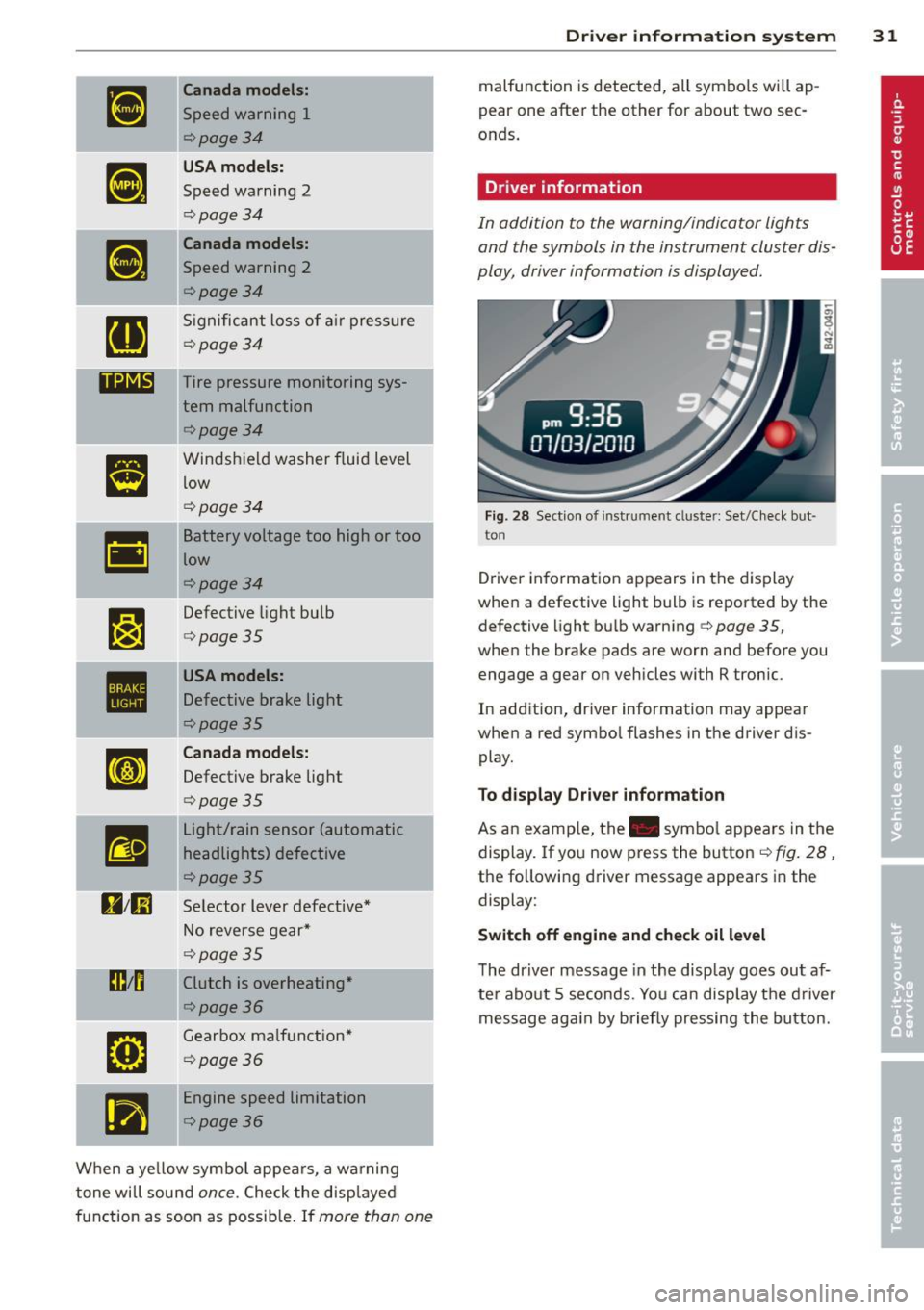
•
Canada models:
Speed warning 1
¢page34
•
USA mode ls:
Speed warning 2
¢page 34
•
Canada model s:
Speed warning 2
¢page34
RI
S ignificant loss of a ir pressure
¢page34
lliliE Tire pressure monitoring sys-
tern malfunction
¢page34
a
Windshield washer f luid level
low
¢page34
-
II Battery voltage too high or too
low
,. ¢page 34
~:~
Defective light bulb
¢page 35
•
lrusA models:
Defective brake light
9page35
•
Canada model s:
Defective brake light
c!>page35
m
Light/rain sensor (automatic
headlights) defective
¢page35
ll 11il Selector lever defective*
No reverse gear *
¢page 35
min Clutch is overheating*
¢page36
D
Gearbox ma lf u nction*
¢page 36
(a
II Engine speed limitation
ll¢page36
W hen a yellow symbo l appea rs, a wa rning
tone will sound
once. Check the disp layed
function as soon as possib le . If
more than one
Dr iver in formation system 31
malfunction is detected, all symbo ls wi ll ap
pear one after the other for about two sec
onds .
Driver information
In addition to the warning/indicator lights
and the symbols in the instrument cluster dis
play, driver information is displayed.
Fig. 2 8 Section of instrument cluster: Set/C heck but·
ton
Driver in format io n ap pears in the d is p lay
when a defective light bulb is reported by the
defective light bu lb warning ¢
page 35 ,
when the brake pads are worn and before you
engage a gear on vehicles with R tronic .
In addition, driver information may appear
when a red symbo l flashes in the driver dis
play.
To d isplay Driver information
As an examp le, the . symbo l appears in the
display. If you now press the button¢
fig. 28,
the following driver message appears in the
display:
Switch off engine and check oil le vel
T he dr iver message in the display goes out af
ter abo ut 5 seconds. Yo u can disp lay t he driver
message aga in by briefly pressing the button.
Page 38 of 244
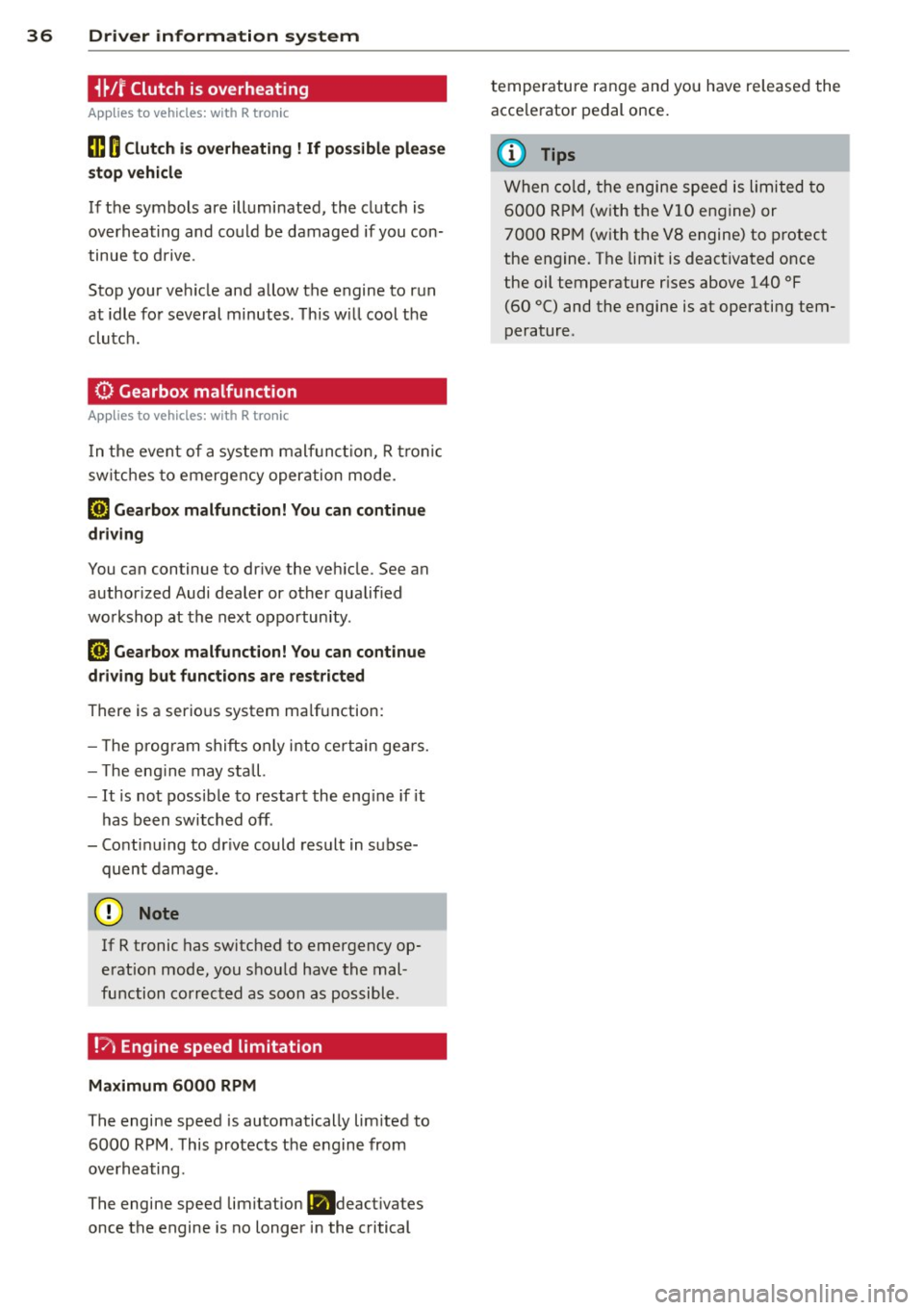
36 Driver information system
i~/r Clutch is overheating
Applies to vehicles: with R tronic
ffl O Clutch is overheating ! If possible please
stop vehicle
If the symbols are illuminated, the clutch is
overheating and could be damaged if you con
tinue to drive .
Stop your vehicle and allow the engine to run
at idle for several minutes . This will cool the
clutch.
0 Gearbox malfunction
Appl ies to vehicles: with R tronic
In the event of a system malfunction, R tronic
switches to emergency operation mode.
[O] Gearbox malfunction! You can continue
driving
You can continue to drive the vehicle. See an
author ized Audi dealer or other qualif ied
workshop at the next opportunity .
[O] Gearbox malfunction! You can continue
driving but functions are restricted
There is a serious system ma lfunction:
- T he prog ram shifts only into certain gears.
- T he eng ine may sta ll.
- It is not possible to restart the engine if it
has been switched off .
- Continuing to dr ive could result in subse
quent damage .
(D Note
If R tronic has switched to emergency op
eration mode, you should have the mal
function corrected as soon as possible.
!?) Engine speed limitation
Maximum 6000 RPM
The engine speed is automatically lim ited to
6000 RPM . This protects the engine from
overheating .
The engine speed limitation
(ll deact ivates
once the engine is no longer in the critical temperature range and you have released the
acce lerator pedal once.
(D Tips
When cold, the engine speed is limited to
6000 RPM (with the
VlO engine) or
7000 RPM (with the VS engine) to protect
the engine . The limit is deactivated once
the oil temperature rises above 140 °F
(60
°() and the engine is at operating tem
perature.
Page 82 of 244
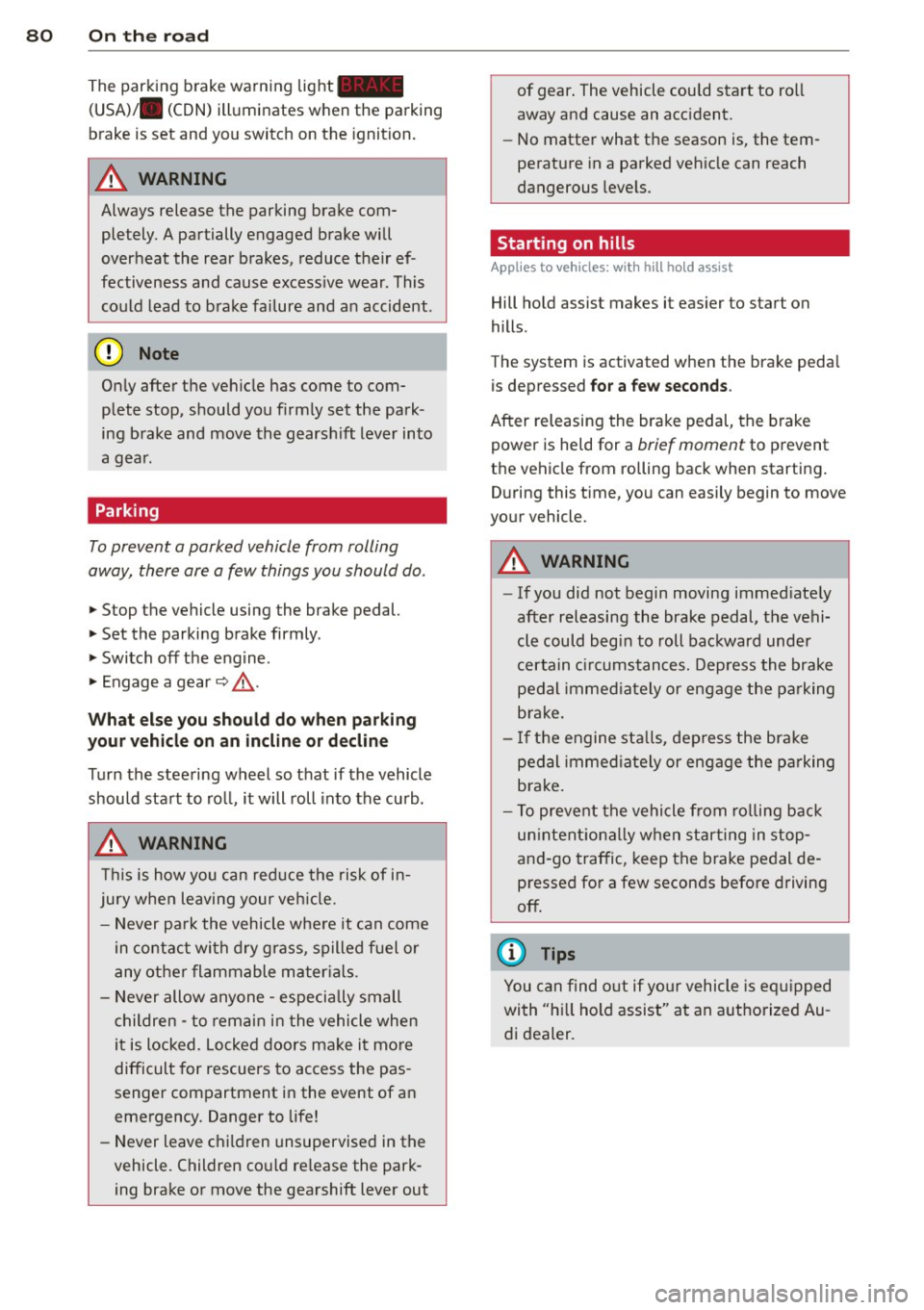
80 On the road
The parking brake warning light_
(USA)/ . (CON) illuminates when the parking
brake is set and you switch on the ignition.
A WARNING
-
Always release the parking brake com
pletely. A partially engaged brake will
overheat the rear brakes, reduce their ef
fectiveness and cause excessive wear. This could lead to brake failure and an accident .
(D Note
Only after the vehicle has come to com
plete stop, should you firmly set the park
ing brake and
move the gearshift lever into
a gear.
Parking
To prevent a parked vehicle from rolling
away, there are a few things you should do .
.. Stop the vehicle using the brake pedal.
.. Set the parking brake firmly .
.. Switch off the engine.
.. Engage a gear
q ,&. .
What else you should do when parking
your vehicle on an incline or decline
Turn the steering wheel so that if the vehicle
should start to roll, it will roll into the curb.
A WARNING
This is how you can reduce the risk of in
jury when leaving your vehicle.
- Never park the vehicle where it can come
in contact with dry grass, spilled fuel or
any other flammable materials.
- Never allow anyone - especially small
children - to remain in the vehicle when
it is locked. Locked doors make it more
difficult for rescuers to access the pas
senger compartment in the event of an
emergency. Danger to life!
- Never leave children unsupervised in the
vehicle. Children could release the park
ing brake or
move the gearshift lever out
-
of gear. The vehicle could start to roll
away and cause an accident.
- No matter what the season is, the tem
perature in a parked vehicle can reach
dangerous levels.
Starting on hills
Applies to vehicles: with hill hold assist
Hill hold assist makes it easier to start on
hills .
The system is activated when the brake pedal
is depressed
for a few seconds.
After releasing the brake pedal, the brake
power is held for a
brief moment to prevent
the vehicle from rolling back when starting.
During this time, you can easily begin to
move
your vehicle.
A WARNING
-- If you did not begin moving immediately
after releasing the brake pedal, the vehi
cle could begin to roll backward under
certain circumstances. Depress the brake
pedal immediately or engage the parking
brake.
- If the engine stalls, depress the brake
pedal immediately or engage the parking
brake.
- To prevent the vehicle from rolling back
unintentionally when starting in stop
and-go traffic, keep the brake pedal de
pressed for a few seconds before driving
off.
(D Tips
You can find out if your vehicle is equipped
with "hill hold assist" at an authorized Au
di dealer.
Page 88 of 244
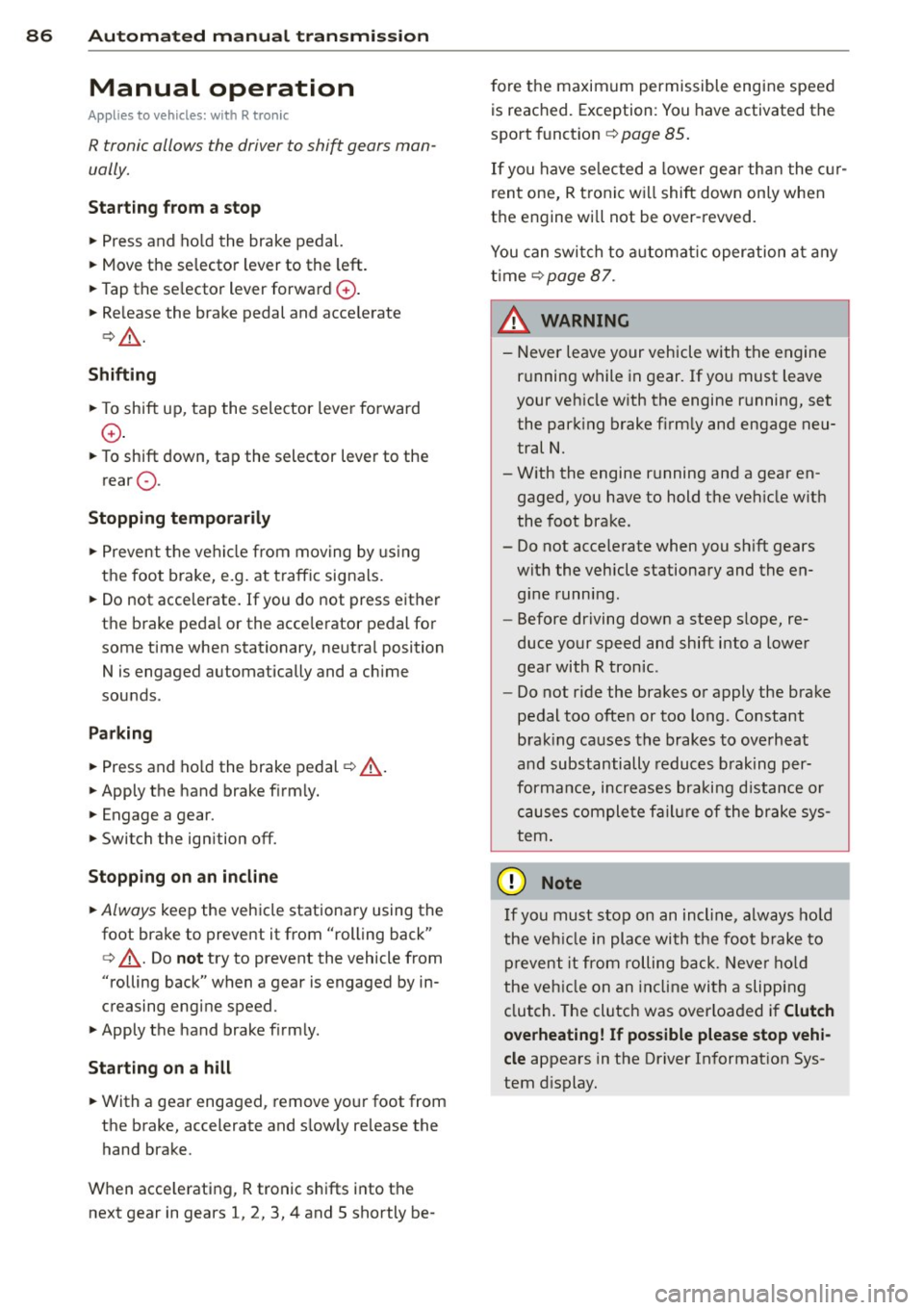
86 Automated manual transmi ssion
Manual operation
Appl ies to vehicles: with R tronic
R tronic allows the driver to shift gears man
ually.
Starting from a s top
,,. Press and ho ld the brake pedal.
,,. Move the selector lever to the left.
,,. Tap the se lector lever forward
G) .
,,. Re lease the brake pedal and accelerate
c:> & .
Shifting
,,. To shift up, tap the selector lever forward
G) .
,,. To shift down, tap the selector lever to the
rear Q.
Stopping t empor arily
,,. Prevent the vehicle from moving by using
the foot brake, e.g. at traffic signals .
,,. Do not acce lerate. If you do not press either
the brake pedal or the acce lerator pedal for
some time when stationary, neutra l position
N is engaged automatically and a chime
sounds.
P ark ing
,,. Press and ho ld the brake pedal c:> A .
,,. Apply the hand brake firm ly.
,,. Engage a gear.
,,. Switch the ignition
off.
St opping on an incline
,,. Always keep the veh icle stationary using the
foot brake to prevent it from "rolling back"
c:> A . Do not try to prevent the vehicle from
"rolling back" when a gear is engaged by in
creasing engine speed.
,,. Apply the hand brake firmly.
St arting on a h ill
,,. With a gear engaged, remove your foot from
the brake, accelerate and s low ly release the
hand brake.
When acce lerating, R tronic shifts into the
next gear in gears 1, 2, 3, 4 and 5 shortly be- fore the maximum permissible engine speed
is reached. Exception: You have activated the
sport funct ion
r::!) page 85 .
If you have se lected a lower gear than the c ur
rent one, R tronic will shift down only when
the engine wi ll not be over-revved .
You can swi tch to a utoma tic operation at any
t ime
<:!)page 87.
& WARNING ~
- Never leave your vehicle with the engine
r u nning while in gear. If you must leave
your vehicle with the engine running, set the park ing brake f irm ly and engage neu
tral N.
- With the engine r unning and a gear en
gaged, you have to hold the veh icle w ith
the foot brake .
- Do not accelerate when you sh ift gears
with the vehicle stationary and the en
g ine runn ing.
- Before driving down a steep slope, re
duce your speed and shift into a lower
gear with R tronic .
- Do not ride the brakes or apply the brake
pedal too often or too long . Constant
brak ing causes the brakes to overheat
and substantially reduces braking per
formance, increases braking d istance or
causes complete failure of the brake sys
tem .
(D Note
If you must stop on an incline, always ho ld
the veh icle in place with the foot b rake to
prevent it from rolling back. Neve r ho ld
the veh icle on an incline with a slipping
clutch. The clutch was overloaded if
C lutch
overheat ing! If po ssible ple ase stop vehi
cle appears in the Driver Informat ion Sys
tem d isplay.
Page 97 of 244
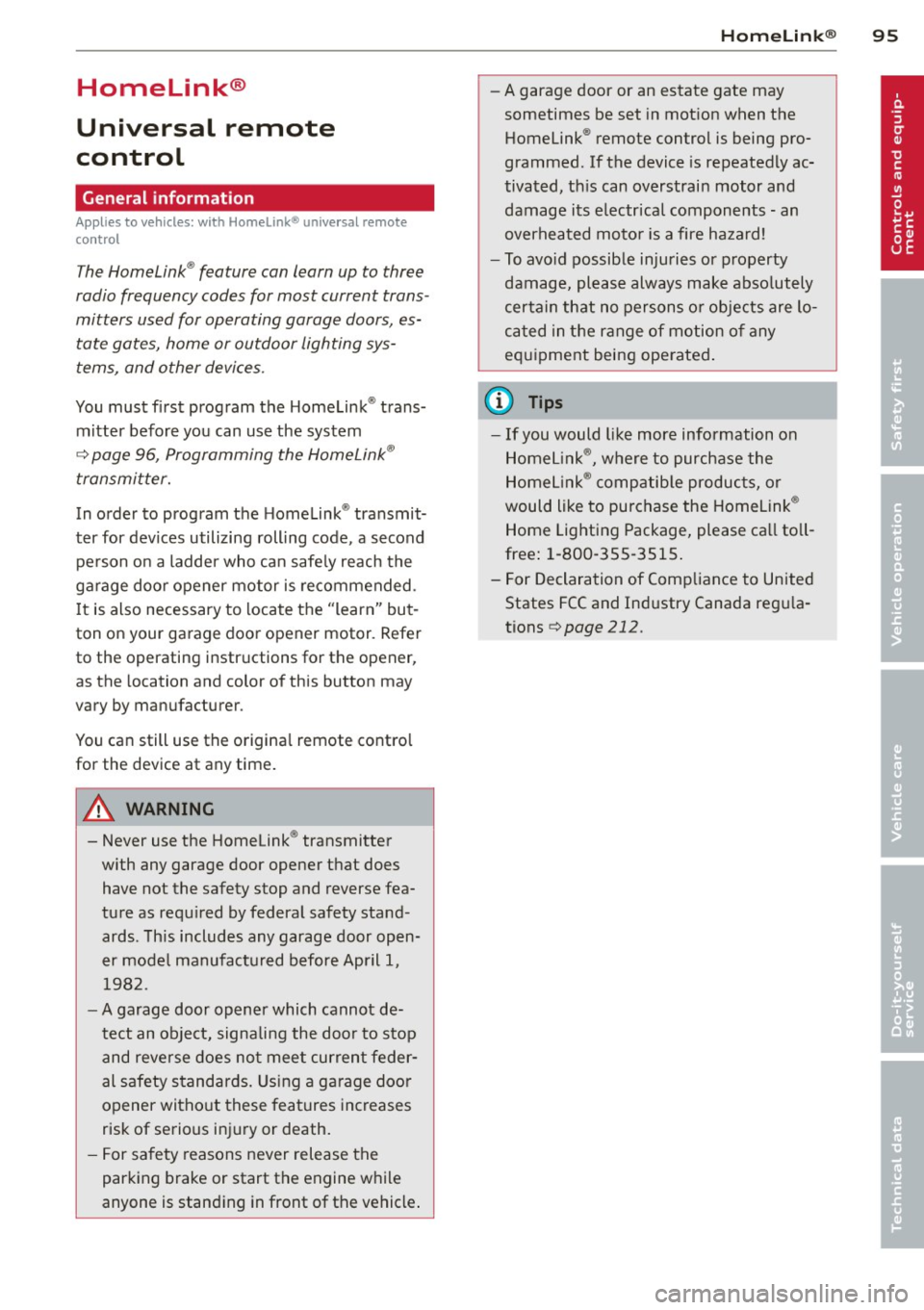
Homelink®
Universal remote
control
General information
Appl ies to vehicles: with Horne Link® universal rem ote
control
The Homelink ® feature can learn up to three
radio frequency codes for most current trans
mitters used for operating garage doors, es tate gates, home or outdoor lighting sys
tems, and other devices.
You must first program the Homelink ® trans
mitter before you can use the system
¢ page 96, Programming the HomeLink ®
transmitter.
In order to program the Home link ® transmit
ter for devices utilizing rolling code, a second
person on a ladder who can safe ly reach the
garage door opener motor is recommended.
I t is also necessary to locate the "learn" but
ton on your garage door opener motor . Refer
to the operat ing instruct ions for the opener,
as the location and color of this button may
vary by manufacturer.
You can still use the origina l remote control
for the device at any time.
A WARNING
-
- Never use the Homelink ® transmitter
with any garage door opener that does
have not the safety stop and reverse fea
tu re as requ ired by federa l safety stand
ards . Th is includes any garage door open
er mode l manufact ured before April 1,
1982.
- A garage door opener which cannot de
te ct an object, signaling the door to stop
and rever se does no t mee t current feder
al safety standards. Using a ga rage doo r
opener witho ut these features increases
risk of serious inj ury or death.
- F or sa fety reasons never release the
par king brake or start the engine while
anyone is stand ing in front of the vehicle .
Hom elin k® 95
-A garage door or an estate gate may
sometimes be set in mot ion when the
Homelink ® remote control is being pro
grammed . If the device is repeatedly ac
tivated, th is can overstrain motor and
damage its e lectrical components -an
overheated moto r is a fire hazard!
- To avo id possib le injuries or property
damage, please always make abso lutely
certain that no persons o r objects are lo
ca ted in the range of motion of any
equ ipment being ope rated .
(D Tips
-If you would li ke more information on
Homel ink ®, w here to purchase the
Homel ink ® compatib le produc ts, or
would like to purchase the Homelink ®
Home Lighting Package, please ca ll toll
free: 1-800-355-3515 .
- For Declaration of Compliance to United States FCC and Ind ustry Canada reg ula
tions ¢
page 212 .
Page 153 of 244
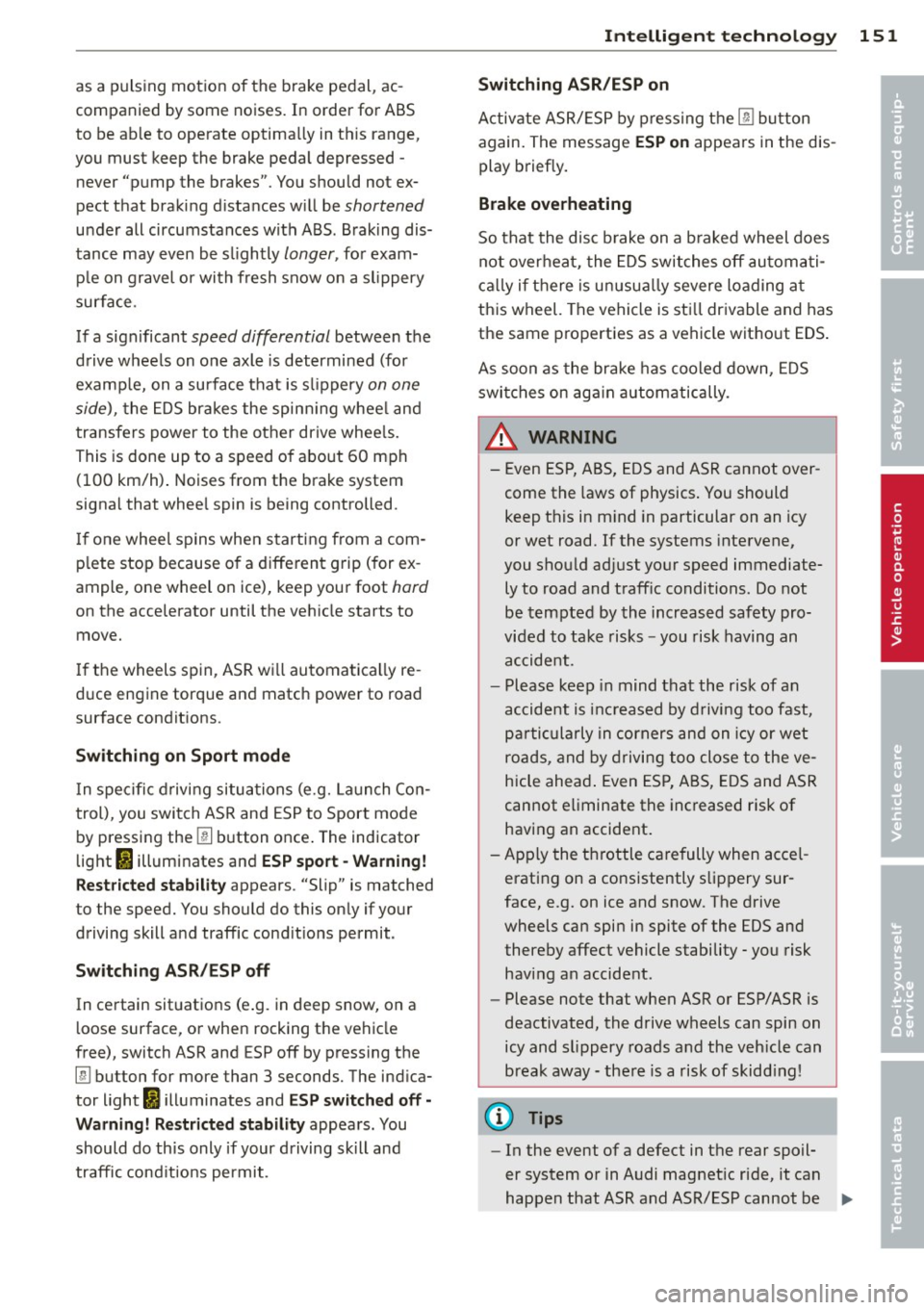
as a pulsing motion of the brake pedal, ac
companied by some noises. In order for ABS
to be able to operate optimally in th is range,
you must keep the brake pedal depressed -
never "pump the brakes" . You should not ex
pect that braking d istances w ill be
shortened
under all circumstances with ABS . Braking dis
tance may even be slightly
longer, for exam
p le on gravel or wi th fresh snow on a slippery
surface .
If a sign ificant
speed differential between the
d rive wheels on one axle is determined (for
examp le, on a su rface that is s lippery
on one
side),
the EDS brakes the spinn ing whee l and
transfers power to the other drive whee ls.
This is done up to a speed of about 60 mph (100 km/h) . Noises from the brake system
signal that whee l spin is being controlled.
I f one whee l spins when starting from a com
p lete stop because o f a different grip (for ex
ample , one wheel o n ice), keep your foot
hard
on the accelerator until the veh icle starts to
move.
If the wheels spin , ASR wi ll automatically re
duce engine torque and match power to road
surface conditions .
Switching on Sport mod e
In specific driving situations (e.g. Launch Con
trol), you swi tch ASR and ESP to Sport mode
by pressing the
[!I button once . The indicator
light
11 illuminates and ESP sport -Wa rni ng!
Restric ted stab ility
appears . "Slip" is matched
to the speed. You should do this only if your
driving skill and traffic cond it ions permit .
Switching ASR /ESP off
In certain sit uations (e .g . in deep snow, on a
l oose surface, o r when rocking the vehicle
free), switch ASR and ESP off by pressing the
[ill button for more than 3 seconds. The ind ica
tor light
I) illuminates and ES P sw itc hed off -
Warning! R estricted stability
appears . You
should do th is only if your driving skill and
traffic cond itions pe rmit .
Int ellig ent technolog y 151
Switching ASR /ESP on
Activate ASR/ ESP by p ressing the [!I button
again. The message
ESP on appears in the d is
play briefly.
Brake overheating
So that the disc b rake on a b raked wheel does
not overheat, the EDS switches off automati
ca lly if there is un usua lly severe loa ding at
th is wheel. The vehicle is st ill drivable and has
the same properties as a vehicle wit hout EDS .
As soon as the brake has cooled down, EDS
swi tches on aga in automatically.
A WARNING
- Even ESP, ABS, EDS and ASR cannot over
come the laws of physics . You should
keep this in m ind in particular on an icy
or wet road. If the systems intervene,
you shou ld adjust your speed immediate
ly to road and traff ic conditions . Do not
be tempted by the increased safety pro
vided to take risks -you risk having an
accident.
- Please keep in mind that the r isk of an
accident is i ncreased by driving too fast,
pa rti cularly in corners and on icy or wet
ro ads, and by drivi ng too close to the ve
hicle ahead . Even ES P, ABS, E DS and ASR
cannot eliminate the increased risk of
having an accident.
-Apply the throttle ca re fully when accel
erating on a consistently s lippery sur
face, e.g. on ice and snow . The drive
wheels can spin in spite of the EDS and thereby affect vehicle stability -you risk
having an accident .
- Please note that when ASR or ESP/ASR is
deactivated, the drive wheels can spin on
icy and slippery roads and the veh icle can
break away -the re is a risk of skidd ing!
(D Tips
- In the event of a defect in the rear spoil-
er system or in Audi magnet ic ride, it can
happen that ASR and ASR/ESP cannot be .,.
•
•
Page 156 of 244
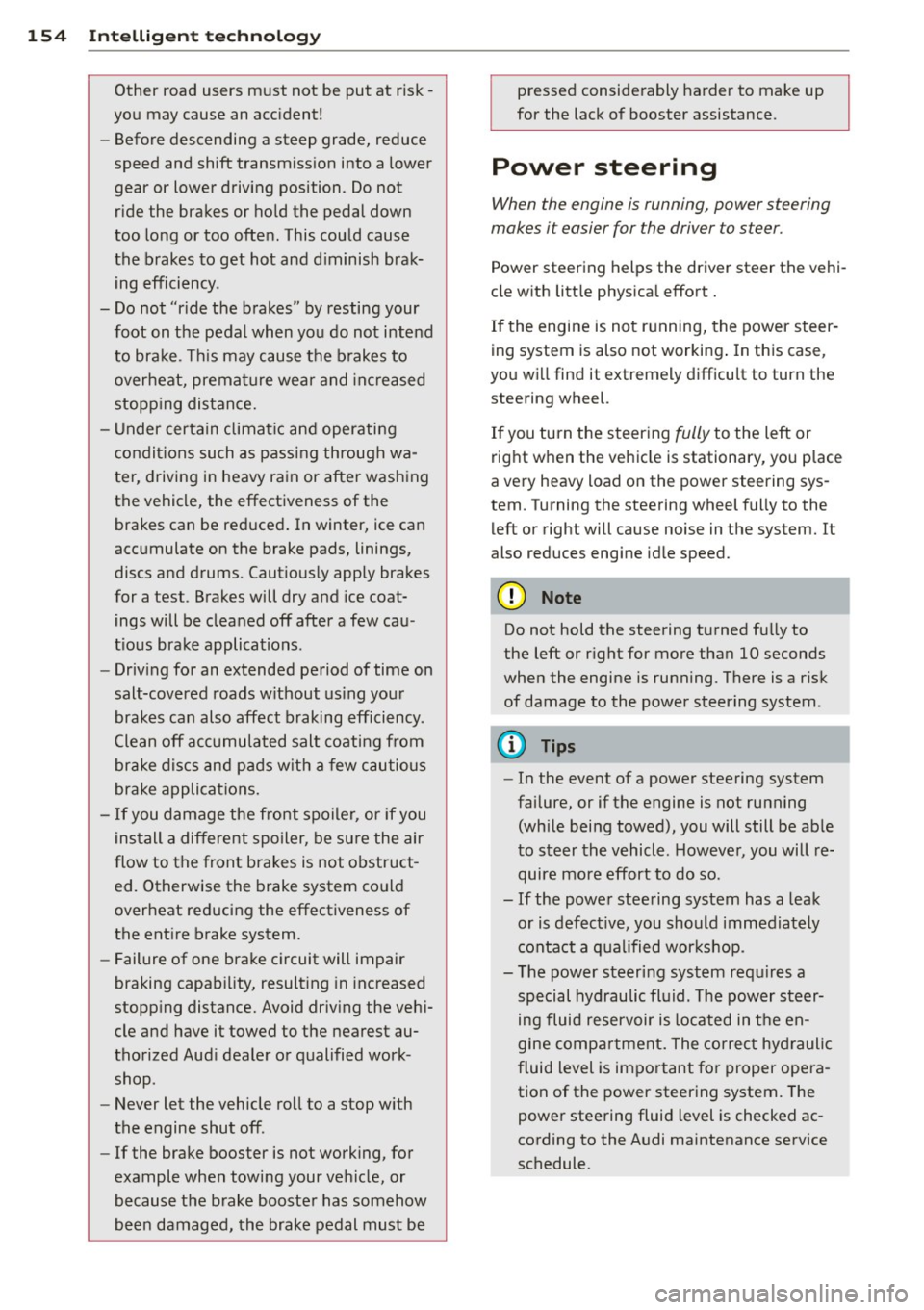
154 Intelligent technology
Other road users must not be put at risk -
you may cause an accident!
- Before descending a steep grade, reduce
speed and shift transmission into a lower
gear or lower driving position . Do not
ride the brakes or hold the pedal down
too long or too often. This could cause
the brakes to get hot and diminish brak ing efficiency .
- Do not "ride the brakes" by resting your
foot on the pedal when you do not intend
to brake . This may cause the brakes to
overheat, premature wear and increased
stopping distance.
- Under certain climatic and operating
conditions such as passing through wa
ter, driving in heavy rain or after washing
the vehicle, the effectiveness of the
brakes can be reduced. In winter, ice can
accumulate on the brake pads, linings,
discs and drums. Cautiously apply brakes
for a test . Brakes will dry and ice coat
ings will be cleaned off after a few cau
tious brake applications .
- Driving for an extended period of time on
salt-covered roads without using your
brakes can also affect braking efficiency .
Clean off accumulated salt coating from
brake discs and pads with a few cautious
brake applications.
- If you damage the front spoiler, or if you
install a different spoiler, be sure the air
flow to the front brakes is not obstruct
ed. Otherwise the brake system could
overheat reducing the effectiveness of
the entire brake system.
- Failure of one brake circuit will impair
braking capability, resulting in increased
stopping distance. Avoid driving the vehi
cle and have it towed to the nearest au
thorized Audi dealer or qualified work
shop.
- Never let the vehicle roll to a stop with
the engine shut off .
- If the brake booster is not working, for
example when towing your vehicle, or because the brake booster has somehow
been damaged, the brake pedal must be pressed considerably harder to make up
for the lack of booster assistance.
Power steering
When the engine is running , power steering
makes i t easier for the driver to steer.
Power steering helps the driver steer the vehi
cle with little physical effort.
If the engine is not running, the power steer
ing system is also not working . In this case ,
you will find it extremely difficult to turn the
steering wheel.
If you turn the steering fully to the left or
right when the vehicle is stationary, you place
a very heavy load on the power steering sys
tem. Turning the steering wheel fully to the left or right will cause noise in the system. It
also reduces engine idle speed.
(D Note
Do not hold the steering turned fully to
the left or right for more than 10 seconds
when the engine is running . There is a risk
of damage to the power steering system .
(D Tips
-In the event of a power steering system
failure, or if the engine is not running
(while being towed), you will still be able
to steer the vehicle. However, you will re
quire more effort to do so .
- If the power steering system has a leak
or is defective, you should immediately
contact a qualified workshop .
- The power steering system requires a
special hydraulic fluid. The power steer
ing fluid reservoir is located in the en
gine compartment. The correct hydraulic
fluid level is important for proper opera
tion of the power steering system. The
power steering fluid level is checked ac
cording to the Audi maintenance service
schedule.
Page 160 of 244
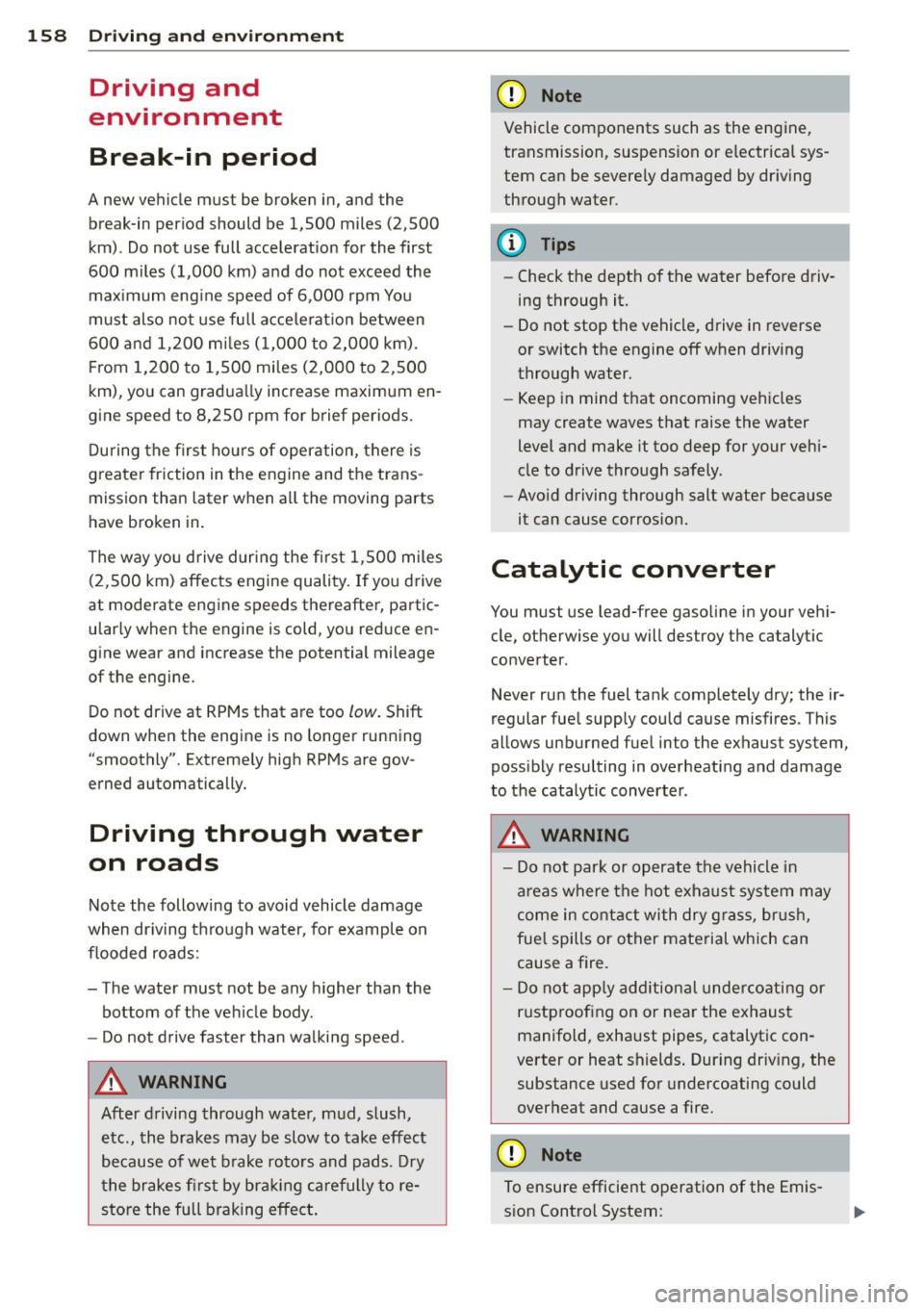
158 Driving and en vi ro nm ent
Driving and
environment
Break-in period
A new vehicle must be broken in, and the break-in per iod should be 1,500 miles (2,500
km) . Do not use full acceleration for the first
600 miles (1,000 km) and do not exceed the
maximum eng ine speed of 6,000 rpm You
must also not use fu ll acce lerat ion between
600 and 1,200 mi les (1,000 to 2,000 km).
F rom 1,200 to 1,500 mi les (2,000 to 2,500
km), you can gradua lly increase maxim um en
gine speed to 8,250 rpm for brief periods.
During the first ho urs of operation, there is
g reater friction in the engine and the trans
mission than later when a ll the moving parts
have broken in.
The way yo u drive duri ng the first 1,500 miles
(2,500 km) affects engine quality. If you drive
at moderate engine speeds thereafter, partic
u lar ly when the engine is cold, yo u reduce en
g ine wear and increase the potential mileage
of the engine.
Do not drive at RPMs that are too low. Shift
down when the engine is no longer running
"smoothly". Extreme ly high RPMs are gov
erned automatically.
Driving through water
on roads
Note the following to avoid vehicle damage
when dr iving through water, for example on
flooded roads:
- The water must not be any higher than the
bottom of the vehicle body .
- Do not drive faster than wa lking speed.
.&_ WARNING
After driving through water, mud, slush,
etc., the brakes may be slow to take effect
because of wet b rake roto rs and pads. Dry
t he brakes fi rst by bra king carefully to re
sto re the full braking effect.
-
(D Note
Vehicle components such as the eng ine,
transmission, suspension or e lectrical sys
tem can be severe ly damaged by dr iv ing
through water.
@ Tips
- Check the depth of the water before d riv
ing through it.
- Do not stop the vehicle, drive in reverse
or switch the engine off when driving
through water.
- Keep in mind that oncoming vehicles
may create waves that raise the water
level and make it too deep for your vehi
cle to drive through safely .
- Avo id driving through salt water because
it can cause corros ion.
Catalytic converter
You must use lead-free gasoline in your veh i
cle, otherwise you will destroy the catalyt ic
converter.
Never run the fuel tank completely dry; their
regular fuel supply could cause misfires . This
allows unburned fuel into the exhaust system,
poss ibly resulting in overheating and damage
to the catalytic converter .
.&_ WARNING ,-
-Do not park or operate the vehicle in
areas where the hot exha ust system may
come in co nta ct with dry g rass, brush,
fue l spills or o ther material which can
cause a fire.
- Do not app ly addition al under coating or
r u stproofing on or nea r the exhaust
manifold, exhaust pipes, catalytic con
verter or heat shields . Dur ing driving, the
substance used for undercoating could
overheat and cause a fire.
(D Note
To ensure efficient o peration of the Emis
s ion Control System:
Page 185 of 244

In a se ale d system, losses can occur only if
the boiling point of the coolant is exceeded as
a result of overheat ing.
A WARNING
- The cooling system is under press ure. Do
not open the cap of the coolant expan
sion tank when the eng ine is hot. You
risk being scalded .
- The coo lant add itive, and therefore the
coolant itse lf, is hazardous to health.
Keep the coolant additive in the origina l
co nta iner out of the reach of children.
It
is a poison hazard.
CD Note
Do not add any type of rad iator leak seal
ant to your vehicle's eng ine coolant. Add
ing radiator repair f luid may adve rsely af
fect the fu nction and performance of your
coo ling system and could res ult in damage
not covere d by your New Vehicle Limited
Warranty .
Adding coolant
Before you check anything in the engine com
partment,
always read and heed all WARN
INGS ¢ & in Working in the engine compart
ment on page 175 .
.. Add coolant .
.. Tw ist the cap on again
t ightly.
.. Tighte n the cap (D ¢ page 182, fig. 146
again .
Replacement engine coolant must conform to
exact specifications ¢
page 181, Coolant. If
the coolant additive Gl2++ is not available in
an emergency, you must not add any other ad
d itive . In th is case, use only water and restore
the co rrec t mix ratio wi th the specified cool
ant add itive as soon as possib le.
Always use
new engine coolant when ref illing .
Do not fill coolant above the " MAX" mark. Ex
cess coolant will be forced out through the p ressure relief valve i n the cap when the en
g ine becomes hot .
Checking and fillin g 183
With a major loss of coolant, you shou ld add
the coolant only when the engine has
cooled.
In this way you prevent engine damage.
A WARNING
- The cooling system is unde r pressure and
can get very hot. Reduce the risk of
scalding from hot coolant by followi ng
these steps .
- Turn off t he engine and allow it to coo l
down.
- Protect you r fa ce, hands and arms from
escaping fluid and steam by covering
the cap with a large, th ic k rag.
- Turn the cap s lowly and very carefully
in a counter -clockwise direction while
applying light, downward pressure on
the top
of the cap.
- To avoid being bu rned, do not spill an
tifreeze or coolant on the ex haust sys
tem or hot engine pa rts. Under certain
cond itions, the ethylene glycol in en
gine coolant can catch fire .
- Antifreeze is poisonous . Always store an
tifreeze in its origina l container and well
out of the reach of children .
- If you dra in the coo lant, it m ust be
caught and safely stored in a proper con
taine r clearly marked " poison" .
CD Note
- Coolant pollutes the environment and
cou ld cause an engine fire. Excess cool
ant will be forced out through the pres
sure relief valve in the cap w hen the en
gine becomes hot .
- If, in an eme rgency, o nly wate r can be
added, the co rrec t ratio between wa ter
and antifreez e
¢page 181 must be re
stored as soon as poss ible.
@) For the sake of the environment
D ra ined coola nt sho uld not be reused. Al
ways d ispose of used coolant while observ
i ng a ll environmental regula tions. •
•